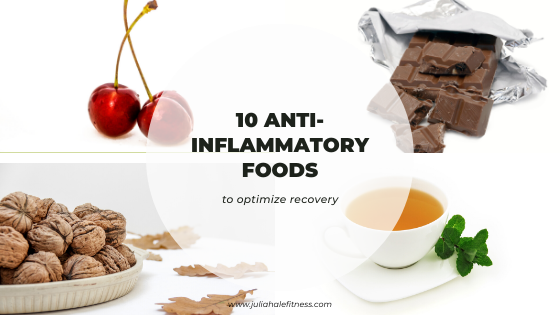
Anti-Inflammatory Foods
Inflammation is your body’s way of telling your immune system to repair the damage or heal a physical injury, and defend itself against foreign invasion (think viruses and bacteria). There are two types of inflammation: classic and systemic.

Classic inflammation, marked by swelling and pain, is your body’s defense mechanism against physical injury. Classic inflammation is short-term and localized. Blood vessels dilate so that blood flow can increase to the injured site in need of repair. Hormones trigger a response from your immune system. When you work out, you create tiny tears in the muscle. This triggers inflammation which begins the repair and recovery process. As your body heals, inflammation dissipates. This is a good thing.
Chronic inflammation, on the other hand, is persistent and systemic. It doesn’t go away, and it does not contribute to repair and recovery. In fact, studies suggest that chronic inflammation increases the risk of lifestyle diseases (so-called because of their link to habits, diet, and other external risk factors), such as diabetes and obesity.
In including anti-inflammatory foods in your diet on a daily basis, you can help to mitigate the existence and effects of inflammation. Consider adding a 1-2 of the following foods to your diet each day to increase health markers and optimize recovery.
10 Anti-Inflammatory Foods to Optimize Exercise Recovery:
Pineapple
1 cup of fresh pineapple contains 131% of your daily requirement of Vitamin C, 2.3 grams of fiber, potassium, beta-carotene, and other anti-oxidants. It also contains bromelain, a protein-digesting enzyme with an ancient history of medicinal usage. Frozen pineapple is the perfect frozen ingredient to add a hit of tropical sunshine to your protein smoothie!
Wild Salmon
You’re probably familiar with omega-3 fatty acids. They’re having a shining-moment in the health world and for good reason: omega-3 fatty acids (specifically DHA and EPA, the two found in abundance in fatty fish like wild salmon), lower inflammation and cannot be produced by the body. You must get them through your dietary choices. Other fatty fish like sardines, mackerel, and trout are good sources on inflammation-fighting omega-3s as well. My favorite way to cook salmon: sear it until it’s crispy and serve it with kale and avocado (another couple of anti-inflammatory foods to add to your repertoire).
Broccoli
Broccoli, a vegetable in the cruciferous family, offers 85 mcg of Vitamin K per 1/2 cup. Several chronic diseases that are linked to inflammation, such as inflammatory bowel disease and osteoporosis, are also associated with a Vitamin K deficiency. Unfortunately, most of us don’t consume enough in our diet. Cooking broccoli in 1-2 teaspoons of olive throw in an extra 10 mcg Vitamin K per serving!
Beets
Beautiful beets (as my mom calls them), come in a variety of hues, but nothing screams “antioxidants!” like the red hue of a purple or red beet. Beets contain betalains, a powerful nutrient that fights inflammation at a cellular level. Beetroot juice contains the same nutrients, so feel free to add this nutrient to your diet in the liquid form.
Green Tea
Green tea contains a natural chemical called catechins. This not only decreases inflammation but it seems to increase fat burning and stimulate weight loss. If you are sensitive to caffeine, consider introducing green tea to your diet in small doses, if at all. And avoid drinking in the late afternoon and evening hours.
Turmeric
Turmeric contains curcumin, a potent antioxidant that boosts anti-inflammatory response and inhibits the formation of other inflammatory compounds within the body. Also, turmeric, the spice widely used in India cuisine (the ingredient that gives curries their yellow hue), has been used medicinally in India for thousands of years. Curcumin is fat-soluble, so your best bet for absorption is to eat it with a fatty meal, like coconut curry.
Tomatoes
Tomatoes are nightshade vegetables that have been shown to reduce inflammation. Why? Because lycopene, the same antioxidant that gives tomatoes (and watermelon), their red/pink hue, is a powerful chemical in your body as well. If you’re less of a tomato salad person and more of a spaghetti sauce person, no worries – cooked tomatoes actually provide more lycopene than raw tomatoes.
Cherries
Cherries, specifically tart cherries and tart cherry juice, fights inflammation and boosts post-workout recovery. Tart cherry juice contains 330 mg potassium per cup which is about 10% of your recommended daily intake and helps to maintain steady blood pressure, boost muscle recovery, aid digestion, and reduce pain and inflammation. When buying, make sure to look for 100% juice
Walnuts
Walnuts, like most nuts, are a great, vegetarian source of omega-3 fatty acids. Also, walnuts are specifically high in ALA, which have been found to lower C-reactive protein, an inflammation marker linked to increased risk of certain cardiovascular diseases. Walnuts are a great addition to veggie burgers, salads, muffins, and oatmeal.
Dark Chocolate
Chocolate is a treat, yes? Yes…but chocolate, specifically dark chocolate, contains anti-inflammatory benefits as well. The cocoa in dark chocolate contains flavonols, which neutralize free radicals and reduces oxidative stress. So if you’re looking for a treat at the end of the day, choosing a bite of dark chocolate (70% or higher), is a great way to satisfy your craving and contribute to your body’s recovery efforts at the same time.
And a quick note on what not to eat…
Just as antioxidant-rich foods have been closely linked to anti-inflammatory benefits and a lower risk of certain lifestyle diseases, there are other foods that have the opposite effect. Namely highly-processed foods are high in fat and sugar. When in doubt, opt for whole, real foods with a high-nutrient density in favor of anything that comes in a fancy package with glowing health claims.



